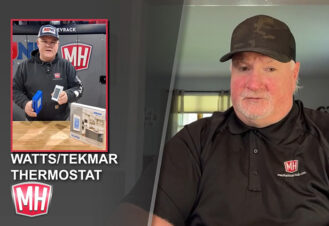The right residential water heater solution depends on multiple factors
Tankless water heaters are one of the most talked-about topics in the home services industry. The rising popularity of tankless water heater technology is being driven by the perception that tankless heaters provide the same dependable performance as traditional tank-type units while using less energy and taking up less space.
That is true for certain single-family residential applications. The efficiency and reliability of tankless technology is sufficient to meet many household needs. As long as homeowners do their homework, have a clear understanding of their hot water usage, and work with a professional to select and install the right equipment, there are usually very few issues.
In many circumstances, however, traditional tank-type water heaters still offer maximum performance, reliability and value, and remain a solid option to meet the hot water needs of most families. Both tankless and tank-type applications can be an appropriate solution, depending on a number of factors, including the size of a home, its existing water heater configuration, the demand for hot water, budget, fuel type availability and personal preference.
For a typical residential application — a single-family home with two bathrooms, standard shower heads, a dishwasher and washing machine — one tankless unit will usually be sufficient. But homeowners can run into issues with high-flow, high-demand luxury fixtures, like a car wash shower head or a 90-gallon soaking tub. People may find that their new tankless product works fine 99% of the time, but they can’t get sufficient water pressure out of their high-flow shower head. This is because the flow rate of the fixture exceeds the amount that the unit can produce. Additionally, remodeling or adding to a home with an existing tankless water heater might create more demand than the installed unit can supply.
In those situations, a tankless water heater paired with a storage tank might be the only available option. But this approach is rarely a preferred solution, because most homeowners choose tankless in the first place because they wanted its efficiency or space-saving features.
Tank-type water heaters maintain a constant reservoir of hot water. Tankless heaters only work when a fixture opens, using less energy overall. But tankless requires more energy when it is used, making the transition from tank to tankless a challenge in many circumstances.
Most gas tankless water heaters provide between 120,000 and 199,000 BTUs, compared to about 40,000 BTUs for tank-type residential gas heaters. In order to switch from a gas tank-type heater to tankless gas, the capacity of the gas line may need to be increased, adding complexity and cost to installation. Similarly, an electric tankless water heater can use double or triple the power of an electric storage tank heater, requiring major electrical upgrades.
Venting is another potential roadblock in transitioning from tank to tankless. Adding or expanding the capacity of existing exhaust and intake pipes may be required, which could mean cutting additional holes in the walls and roof.
Maintenance is critical for the longevity and performance of tankless water heaters. Unfortunately, water heaters tend to be the forgotten appliance. They’re hidden behind a utility door or inside a closet, and many people don’t think about them until there’s an issue and they don’t have hot water.
We know many people don’t keep up with the recommended maintenance of their water heaters, but tank-type units can last for 10 years or more with few problems. Tankless water heaters, however, are more likely to show reduced performance and suffer breakdowns if users don’t follow a regular maintenance schedule.
As the popularity of tankless water heaters continues, new features are becoming available, such as recirculation, connectivity and built-in buffer tanks. The Bradford White Infiniti® K Series tankless gas water heaters offer top connections, which make switching from a storage tank heater more convenient. At the same time, innovations like electric heat pump water heaters and condensing gas water heaters are opening new possibilities for energy efficiency in tank-type water heaters.
In the end, the distinction between tankless and tank-type water heaters isn’t as neat as it is often presented. Both technologies offer advantages, and tank-type water heaters will continue to be a solution in many circumstances for years to come. It’s about choosing the right product for the job at hand. As long as consumers know what they’re looking for and work with a professional, they can be confident that they’ll find the right configuration for their home.
 GUEST AUTHOR: Trevor Pinto is the Product Manager of Residential Products and Application Support for Bradford White Corporation and has been with the company since 2012. Pinto began his career in the Product Management Department starting out as a Product Analyst and has grown in the ranks over the past several years. In his current role, he oversees the residential product line as well as the application support team. The application support team is responsible for assisting Bradford White’s customer base with selecting the appropriate product for a specific application and providing general product knowledge.
GUEST AUTHOR: Trevor Pinto is the Product Manager of Residential Products and Application Support for Bradford White Corporation and has been with the company since 2012. Pinto began his career in the Product Management Department starting out as a Product Analyst and has grown in the ranks over the past several years. In his current role, he oversees the residential product line as well as the application support team. The application support team is responsible for assisting Bradford White’s customer base with selecting the appropriate product for a specific application and providing general product knowledge.
Prior to joining Bradford White, Trevor graduated from Indiana University of Pennsylvania with a bachelor’s degree in Criminology. He grew up in the Philadelphia suburbs and is a passionate Philadelphia sports fan, enjoys music and the outdoors including camping, hiking, and fishing. He currently resides in Lansdale, PA with his wife and two children.




Join the conversation: